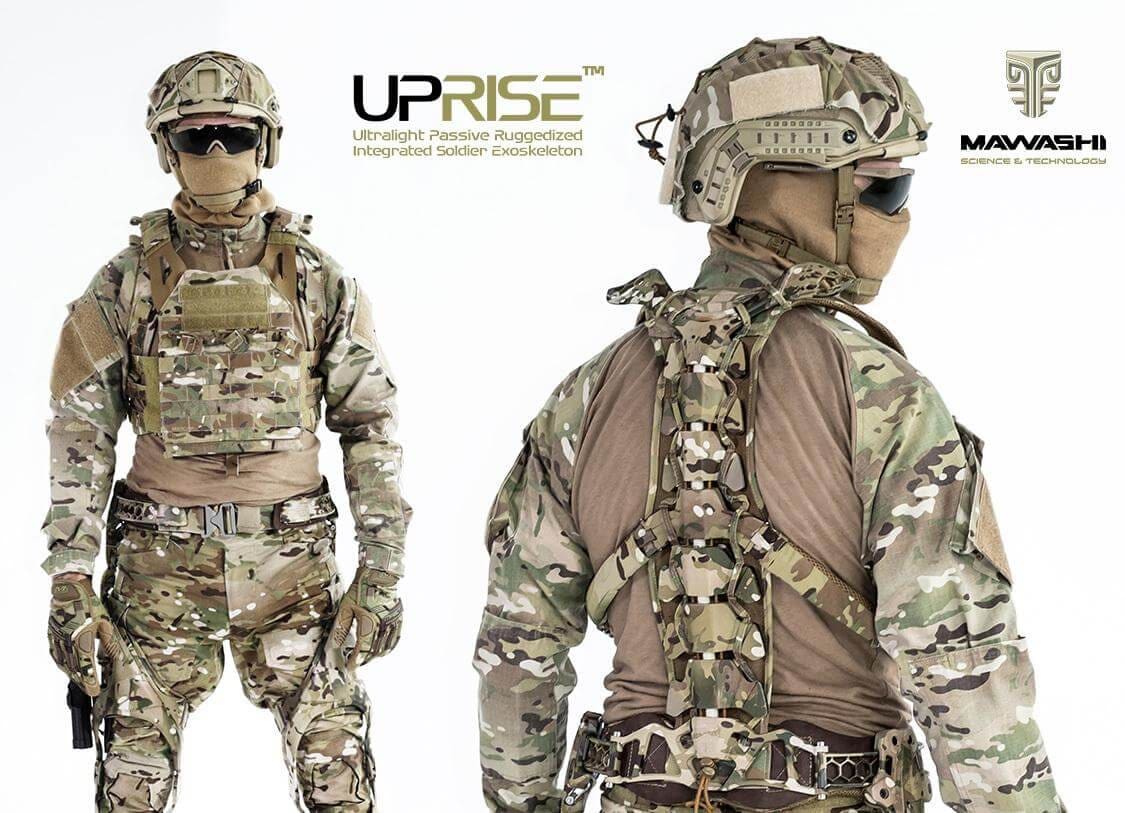Last year we introduced the Mawashi UPRISE Exoskeleton to you. It’s an human powered system, designed to reduce injuries and fatigue.

This video shows Mawashi personnel demonstrating the Exoskeleton in various Simulated Training and Operational Environments, including:
· Gait Kinematics Analysis in Biomechanical Laboratory
· Obstacle Course Training
· Close-Quarter Combat (CQC) / Close-Quarter Battle (CQB)
· Tactical Urban Rappelling
· Chemical, Biological, Radiological, Nuclear and Explosives (CBRNE) Environment
· Amphibious Assault with Combat Rubber Raiding Craft (CRRC)
· Stealth Amphibious Operations with Closed-Circuit Rebreather
· Scouting & Patrolling in Woodland Environment
· Rapid Mobile Assault with Lightweight Tactical All-Terrain Vehicle (LTATV)
· Long-Range Sniper Reconnaissance & Infiltration with Ghillie Suit
· Tactical Mountain Rappelling
· Emergency Exfiltration under Heavy Mortar Fire
· Open Ground Firefight with Assault Rifle
Tags: Mawashi


Ingenious idea, however, what happens when rounds/frag start hitting this thing and possibly making worse wounds?
How mature is the technology? Any of the boys in and around Bragg tested it yet? What’s up with getting a couple for a warfighter assessment?
I think this is brilliant. It’s the right intermediate step to powered exoskeletons (which are still pretty far away due to battery tech) and probably a better foundation to build one from once the power tech catches up.
Slick video. Who cares. How much more can a guy squat, clean, Dead lift? Where are the numbers indicating a faster 10k ruck over varied terrain? Faster 100m time in combat equipment?
^^ This…. I’m in full agreement…..I am not hating on the technology, but I want data not more multicam clad go fast commando cinema…. its looks like just more gear to wear with no tangible performance benefits its wasn’t integrating with armor and the guy looked like he still struggled to stand up from the kneeling with his gigantosaurus ruck on!?? Sorry looks like hype to me.
show me the metrics (that matter)
Thank you all for your feedback, it is highly appreciated.
The UPRISE Technology is presently at the Pre-Commercialization Stage.
Please understand that the UPRISE Exoskeleton is a passive wearable device that aims at lessening the load burden and, more importantly, preventing musculoskeletal injuries. It was not designed to enhance muscular strength. As shown in the video, this Exoskeleton demonstrates a high level of mobility and agility, thus enhancing the soldier’s performance in dynamic environments.
As well, it is to note that nearly one-third of all medical evacuations from Iraq and Afghanistan from 2004 through 2007 resulted from musculoskeletal, connective-tissue or spinal injuries, according to a study led by a Johns Hopkins University researcher. That was more than double the number of evacuations from combat injures. (Source: https://www.seattletimes.com/nation-world/weight-of-war-gear-that-protects-troops-also-injures-them/)
Dismounted soldiers equipped with the UPRISE Exoskeleton would be considerably more efficient for an extended mission during which they carry heavy loads on their back. As an example, the document entitled “The Modern Warrior’s Combat Load” published by the U.S. Army Center for Army Lessons Learned (Source: http://thedonovan.com/archives/modernwarriorload/ModernWarriorsCombatLoadReport.pdf) states that for an Average Mission Duration of 48-72 hours, a Rifle Squad Leader carries on average 62.43 lbs (Average Fighting Load), 94.98 lbs (Average Approach March Load), and 128.35 lbs (Average Emergency Approach March Load). Therefore, many musculoskeletal injuries are caused by excess loads and/or prolonged excessive carried loads. Common injuries associated with prolonged load carriage include foot blisters, stress fractures, back strains, metatarsalgia (foot pain), rucksack palsy (shoulder traction injury) and knee pain.
Furthermore, the UPRISE Exoskeleton is presently undergoing user trials in laboratory and obstacle course conditions with certain NATO nations. We are in the process of gathering relevant data (metrics) that will demonstrate the Exoskeleton’s Injury Prevention Capability by improving the blood flow, reducing the compression of the spine and peripheral nervous system, and offloading the knee joint and lower back with hard stops to reduce the occurrence of Anterior Cruciate Ligament (ACL) and Posterior Cruciate Ligament (PCL) knee injuries.
The document “Soldiers load and the mobility of a nation” by SLA Marshall taught me how to reduce overloading injuries as well. Get the load off of the soldiers back.
Thanks for taking the time to interact with this forum. Good luck with your testing. Looking forward to seeing measurable results that matter.
So we should wear more gear because we are wearing too much gear?…..Interesting…but stupid… You developed a really expensive Multicam back brace, you should go back the drawing board. This problem is solved buy going to the gym and staying in good shape, and also a responsible chain of command that purchases lighter equipment and that doesn’t over burden their forces with excessive loads….The SOF community kinda has it figured out…So good luck.
Does the back brace separate from the waist belt on demand?